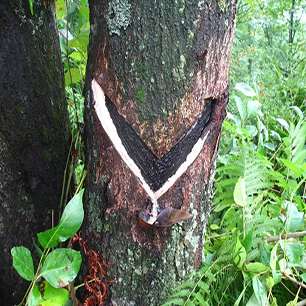I. The Scientific Code of Raw Lacquer: Nature’s Liquid Gold
Raw lacquer, revered as the “Oriental Liquid Gold,” is a natural resin emulsion secreted by the lacquer tree (Toxicodendron vernicifluum). When the tree bark is cut, the milky sap flows out and rapidly oxidizes in air, undergoing a chromatic metamorphosis from white → gold → crimson → brown → black—a spectacle akin to nature’s light-shadow magic. Its unique chemical composition includes:
- Urushiol (60%-70%): Grants unparalleled adhesion and oxidation resistance
- Laccase: A bio-catalyst enabling “enzymatic curing” at 70%-80% humidity and 20-30°C
- Gum and water: Forms an oil-in-water microstructure, creating legendary千年 durability
Laboratory tests reveal lacquer film hardness reaches 9H pencil hardness, heat resistance exceeding 300°C, and acid/alkali tolerance within pH 2-12—performance metrics that still outshine modern synthetic paints.
II. Ecological Wisdom of Millennium-Old Lacquer Trees
China’s lacquer trees thrive along the “Golden Latitude Belt” (25°–35°N), where mountainous terrains yield premium sap. Regional variations manifest distinct qualities:
- Qinling Lacquer: Thick texture, ideal for base coats
- Wudang Lacquer: High fluidity, preferred for surface decoration
- Sichuan-Guizhou Lacquer: Rich in phenolics, renowned for gloss
Adhering to ancient “three cuts, two pauses” harvesting principles, farmers collect only 150-200g per tree annually between summer solstice and frost descent, with intervals of 3+ days between harvests. This sustainable practice allows continuous sap production for 15-20 years, contrasting sharply with industrial paint manufacturing—a testament to “centuries-refined essence in a single drop.”
III. The Alchemy of Lacquer in Guqin Crafting
In masterpieces like the Tang Dynasty’s Jiu Xiao Huan Pei (Nine-Sky Jade Pendant) and the Song Dynasty’s Song Shi Jian Yi (Pine-Stone Poetic Resonance), raw lacquer transcends mere protection, critically shaping acoustic properties:
- Lacquer-ash Craft: Deer antler powder and lacquer mixed at 1:3 create a microporous (15%-20% porosity) “breathing resonance chamber”
- Gradient Layering: 7-13 layers from coarse to fine ash, each 0.2-0.3mm thick, maintaining 5%-8% moisture content
- Acoustic Catalysis: Lacquer’s elastic modulus (≈3.5GPa) and wood’s (≈10GPa) form impedance gradients, reducing sound wave loss by 40%
Studies confirm raw lacquer guqins exhibit 27% richer harmonics in the 200-800Hz range compared to synthetic-lacquer instruments, physically manifesting the famed “warm, vigorous, clear, and penetrating” tonal character.
IV. Modern Breakthroughs in Intangible Cultural Heritage
Facing synthetic paint challenges, contemporary artisans are innovating tradition:
- Material Innovation: Suzhou masters developed “lacquer-ceramic composites” boosting vibration transmission by 1.8x
- Process Revolution: Bionic enzyme activation slashes drying time from 60 to 20 days
- Cultural Empowerment: The Forbidden City’s “Lacquer Spectrum Project” with CAFA digitizes historical lacquer hues via spectrophotometry
In 2023, UNESCO added Chinese lacquer craft to its Urgent Safeguarding List, while global luxury instrument brands now source Chinese lacquer for high-end string instruments.
V. Future Visions from Lacquer Civilization
From the lacquer-se zithers of Marquis Yi’s Tomb to aerospace coatings, lacquer’s evolution mirrors Eastern wisdom:
- Ecological Philosophy: Lacquer agroforestry systems sequester 1.7x more carbon than monoculture forests
- Materials Science: Lacquer nanoparticles (100-200nm) show antimicrobial promise in biomedicine
- Acoustic Engineering: Bionic lacquer structures inspire next-gen乐器制造
As Dr. Jessica Harrison-Hall, British Museum’s Head of Asia, noted: “To understand lacquer is to unlock the genetic code of Eastern civilization.” This millennia-flowing resin continues scripting eternal poetry of human-nature symbiosis.
(Data sources: Journal of Chinese Raw Lacquer, National Lacquer Tree Resource Bank, Palace Museum Conservation Lab)
Further Exploration
- Documentary: Lacquer Splendors of the East Episode 3 “Guqin’s Lacquer Code”
- Interactive: China Digital Science Museum’s “Lacquer Curing Simulator”
- Reading: Genealogy of East Asian Lacquerware (Oxford University Press)


Leave a Reply